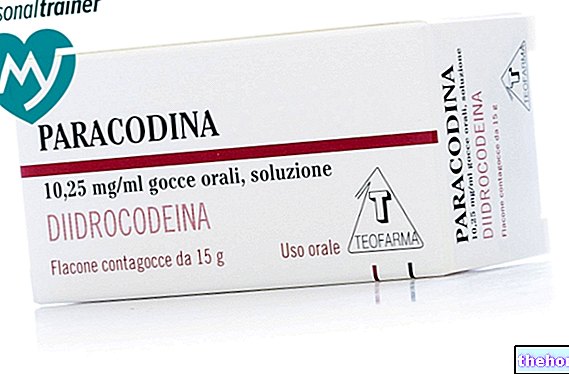Active ingredients: Chloramphenicol, Colistin (Sodium colistimethate), Rolitetracycline
Eye drops, powder and solvent for solution and ophthalmic ointment
Why is Colbiocin used? What is it for?
Pharmacotherapeutic group
Colbiocin is a combination of three antibiotics, two of which have a broad spectrum of action. Colbiocin is effective in the treatment of external ocular infections caused by Gram positive, Gram negative and Chlamydia germs.
Therapeutic indications
Treatment of external eye infections such as catarrhal, purulent conjunctivitis, trachoma, blepharitis, blepharoconjunctivitis, bacterial keratitis, septic corneal ulcers, dacryocystitis.
Contraindications When Colbiocin should not be used
Known individual hypersensitivity to the drug.
Precautions for use What you need to know before taking Colbiocin
In very early childhood and pregnancy, the product should be administered in cases of real need, under the direct supervision of the doctor.
Interactions Which drugs or foods can modify the effect of Colbiocin
There are no known drug interactions deriving from the topical use of the product.
Warnings It is important to know that:
Prolonged use of topical antibiotics can lead to the growth of microorganisms that are not sensitive to them.
If, within a reasonable time interval, there is no evident clinical improvement with the use of the product or if there are manifestations of sensitization to the pharmacological components, it is necessary to suspend the treatment and undertake an adequate therapy.
Rare cases of bone marrow hypoplasia have been described following prolonged use of topical chloramphenicol. For this reason, the product should be used for short periods, unless explicitly indicated by the doctor.
The eye drops contain sodium sulphite: this substance can cause allergic reactions and severe asthmatic attacks in sensitive subjects and particularly in asthmatics.
Dose, Method and Time of Administration How to use Colbiocin: Posology
Eye drops, powder and solvent for solution: one or two drops 3-4 times a day or according to medical prescription.
Ophthalmic ointment: 3 - 4 applications per day. If the use of eye drops is also foreseen, an evening application is sufficient.
INSTRUCTIONS FOR USING THE TANK CAP
Remove the aluminum capsule by pulling the central disk first upwards then outwards and downwards, following the indentations.
Remove the cap from the bottle and insert the container cap.
Press the colored button of the container cap and shake the bottle to dissolve the powder.
Remove the cap from the container and apply the dropper.
After removing the protective cap from the dropper, turn the bottle upside down and instill by pressing.
Overdose What to do if you have taken an overdose of Colbiocin
No cases of overdose have ever been reported with the use of Colbiocin at the recommended dosage.
In newborns, especially premature ones, excessive concentrations of chloramphenicol can evoke toxic reactions, even lethal.
Side Effects What are the side effects of Colbiocin
Occasionally Colbiocin can give rise to temporary irritations.
Sensitization reactions such as burning, angioneurotic edema, urticaria, vesicular and maculopapular dermatitis have sometimes been reported. In this case it is advisable to suspend the treatment and resort to adequate therapy.
Patients are asked, if side effects not described in the package leaflet occur, to notify their doctor or pharmacist.
Expiry and Retention
For the expiry date, see the packaging.
Warning: do not use the medicine after the expiry date indicated on the package.
Store below 25 ° C
The ready-to-use eye drops should not be used 15 days after first opening and should be stored in the refrigerator at 2-8 ° C.
Composition and pharmaceutical form
Composition
Eye drops, powder and solvent for solution
100 ml of ready-to-use solution contain:
Active ingredients: Chloramphenicol g 0.400 - Sodium colistimethate I.U. 18,000,000 - Rolitetracycline g 0.500 equal to Tetracycline g 0.421.
Excipients: Borax - Boric acid - Edetate disodium - Polysorbate 80 - Sodium sulphite - Benzalkonium chloride - Purified water.
Ophthalmic ointment
100 g contain:
Active ingredients: Chloramphenicol g 1 - Sodium colistimethate I.U. 18,000,000 - Tetracycline g 0.500.
Excipients: Liquid paraffin - Anhydrous lanolin - White petroleum jelly.
Pharmaceutical form and content
Eye drops, powder and solvent for solution in 5 ml bottle
Ophthalmic ointment in 5 g tube
The variations in color that may present both the powder and the reconstituted eye drops do not affect the therapeutic activity of the product which remains valid for the entire period marked on the package.
Source Package Leaflet: AIFA (Italian Medicines Agency). Content published in January 2016. The information present may not be up-to-date.
To have access to the most up-to-date version, it is advisable to access the AIFA (Italian Medicines Agency) website. Disclaimer and useful information.
01.0 NAME OF THE MEDICINAL PRODUCT
COLBIOCIN
02.0 QUALITATIVE AND QUANTITATIVE COMPOSITION
Eye drops, powder and solvent for solution
100 ml of ready-to-use solution contain:
Chloramphenicol g 0.400 - Sodium colistimethate I.U. 18,000,000 - Rolitetracycline g 0.500 equal to Tetracycline g 0.421.
Ophthalmic ointment
100 g contain:
Chloramphenicol g 1 - Sodium colistimethate I.U. 18,000,000 - Tetracycline g 0.500.
03.0 PHARMACEUTICAL FORM
Eye drops, powder and solvent for solution and ophthalmic ointment.
04.0 CLINICAL INFORMATION
04.1 Therapeutic indications
Treatment of external eye infections such as catarrhal, purulent conjunctivitis, trachoma, blepharitis, blepharoconjunctivitis, bacterial keratitis, septic corneal ulcers, dacryocystitis.
04.2 Posology and method of administration
Eye drops, powder and solvent for solution
One or two drops 3-4 times a day or according to medical prescription.
Ophthalmic ointment
3 - 4 applications per day. If the use of eye drops is also foreseen, an evening application is sufficient.
04.3 Contraindications
Known individual hypersensitivity to the drug.
04.4 Special warnings and appropriate precautions for use
Prolonged use of topical antibiotics can lead to the growth of microorganisms that are not sensitive to them.
If, within a reasonable time interval, there is no evident clinical improvement with the use of the product or if there are manifestations of sensitization to the pharmacological components, it is necessary to suspend the treatment and undertake an adequate therapy.
Rare cases of bone marrow hypoplasia have been described following prolonged use of topical chloramphenicol.For this reason, the product should be used for short periods, unless explicitly indicated by the doctor.
The eye drops contain sodium sulphite: this substance can cause allergic reactions and severe asthmatic attacks in sensitive subjects and particularly in asthmatics.
In very early childhood, the product should be administered in cases of real need under the direct supervision of the doctor.
04.5 Interactions with other medicinal products and other forms of interaction
Chloramphenicol, administered systemically, inhibits hepatic microsomal enzymes of the cytochrome P450 complex. This action can prolong the half-life of some drugs such as Dicumarol, Phenytoin, Chlorpropamide and Tolbutanide.
Chronic administration of Phenobarbital or acute administration of Rifampicin reduces the half-life of Chloramphenicol resulting in the formation of sub-therapeutic concentrations of the drug.
No drug interactions have been detected so far with the topical use of the preparation.
04.6 Pregnancy and lactation
During pregnancy, the product should be administered in cases of real need and under the direct supervision of the doctor.
04.7 Effects on ability to drive and use machines
There are no contraindications.
04.8 Undesirable effects
Occasionally Colbiocin can give rise to temporary irritations.
Sensitization reactions consisting of heartburn, angioneurotic edema, urticaria, vesicular and maculopapular dermatitis may also occur in some patients. In this case it is advisable to suspend the treatment and establish an adequate therapy.
04.9 Overdose
No cases of overdose have ever been reported.
In newborns, especially premature ones, excessive concentrations of chloramphenicol can cause toxic reactions, even lethal.
05.0 PHARMACOLOGICAL PROPERTIES
05.1 Pharmacodynamic properties
Colbiocin is a "combination of antimicrobial drugs.
Chloramphenicol is a broad spectrum bacteriostatic antibiotic active on Gram + and Gram - bacteria, mycoplasma, rickettsiae and chlamydiae. The drug penetrates inside the bacterial cell through a facilitated diffusion mechanism; it acts by binding reversibly with the 50 S subunits of the bacterial ribosome, preventing the binding of the end of the mRNA containing the amino acid to the ribosomal subunit.
The interaction between the peptidyl-transferase and the amino acid does not occur and the formation of the peptide bond is inhibited and so is the protein synthesis. Some bacterial species can develop plasmid-mediated resistance.
Rolitetracycline and Tetracycline are bacteriostatic antibiotics active on Gram + and Gram - bacteria, chlamydiae, mycoplasma, rickettsiae and amoeba. Tetracyclines inhibit the protein synthesis of bacteria. Their seat of action is the bacterial ribosome. In Gram germs - the antibiotic passively diffuses through the hydrophilic channels of the outer cell membrane formed by proteins; subsequently it is transported (according to an energy-dependent mechanism) through the internal cytoplasmic membrane.
The mechanism of action underlying the penetration of Gram + bacteria is less clear; the involvement of an energy-dependent transport mechanism is certain.
Inside the bacterial cell, the Tetracyclines bind to the 30 S subunit of the ribosomes at the level of which they prevent the contact between the aminoacyl-tRNA and the mRNA-ribosome complex by blocking the elongation of the polypeptide chain in formation.
Resistance to tetracyclines develops slowly and is mediated by plasmids.
Colistin is a bactericidal antibiotic isolated from Bacillus Colistinus. The antimicrobial activity of Colistin is limited to Gram - bacteria, including Pseudomonas and Haemophilus.
This antibiotic is an amphoteric surfactant agent therefore it interacts with the phospholipids of the cell membranes, compromising their structural integrity and therefore their permeability.
The combinations Colistin-Tetracycline or Colistin-Chloramphenicol present synergistic action.
05.2 Pharmacokinetic properties
Chloramphenicol is available for oral use in the form of an active drug and an inactive prodrug (Chloramphenicol palmitate). Under normal conditions, the ester bond of chloramphenicol palmitate is hydrolyzed in the duodenum by pancreatic lipases. Chloramphenicol is absorbed from the gastrointestinal tract and maximum plasma concentrations of 10 - 13 mcg / ml are reached within 2-3 hours with the administration of 1 g. Chloramphenicol diffuses well in body fluids (cerebrospinal fluid, bile, milk) and crosses the placenta. Following subconjunctival injection it penetrates into the aqueous humor. The main metabolic pathway is the hepatic one; excretion is urinary.
Due to its marked solubility, Chloramphenicol, applied topically in the conjunctival sac in the form of eye drops or ophthalmic ointment, penetrates the ocular tissues much more quickly and at higher concentrations than other antibiotics and therefore represents a drug of choice also in the treatment of infections. intraocular.
Intravenous administration also ensures high concentrations of the drug in the eye.
Excellent ocular tolerability of the eye drops at concentrations 0.2 - 0.5% and of the 1% ophthalmic ointment.
Chloramphenicol has an extremely low acute toxicity: the LD50 in mice is 245 mg / kg intravenously, 320 mg / kg parenterally and 1,500 - 2,500 mg / kg orally.
Most tetracyclines are absorbed although not completely from the gastrointestinal tract. Absorption is greater on an empty stomach; it is less in the more distal segments of the gastrointestinal tract. It is however impaired by the concomitant ingestion of milk, aluminum hydroxide gel, calcium salts, magnesium, iron and bismuth subsalicylate.
After oral administration, Oxytetracycline and Tetracycline reach maximum plasma concentrations within 2-4 hours. These drugs have half-life times of 6-12 hours. At doses of 250 mg every 6 hours, maximum plasma concentrations of 2-2.5 are achieved. mcg / ml.
Tetracyclines concentrate in the liver and are excreted via the bile in the intestine from where they are partially reabsorbed. Tetracyclines cross the placenta and enter the fetal circulation and amniotic fluid. Tetracyclines concentrations in the umbilical cord plasma reach 60% and in the amniotic fluid 20% of those present in the maternal circulation Relatively high concentrations are found in the breast milk.
The main route of excretion is renal but these antibiotics are also eliminated in the faeces.
Tetracycline and Rolitetracycline, following topical application, do not cause appreciable undesirable effects and are poorly absorbed by the ocular structures.
Tetracyclines have a low acute toxicity: the LD50 in mice is 130 - 180 mg / kg intravenously and 1,500 - 7,000 mg / kg per os.
Colistin is not absorbed when administered orally. Absorption is poor after application to the mucous membranes; it increases if the mucosa is inflamed. Subconjunctival administration determines therapeutically effective intraocular concentrations.
Colistin is a little toxic and well tolerated antibiotic, the LD50 in the endoperitoneal mouse is 300 mg / kg.
05.3 Preclinical safety data
Preclinical studies conducted in order to evaluate the local and general tolerability of the prolonged application (90 days) of Colbiocin on the scarified skin of the rat did not report any behavioral difference in the treated animals; body growth was normal and so were the haematological values. or weight them.
Regarding the local and general tolerability of Colbiocin eye drops and ophthalmic ointment after application for 90 days in the conjunctival sac of the rabbit, no changes in behavior or mortality were found; body growth is normal; the response of lacrimal secretion to Pilocarpine is normal; haematological and chemical parameters are normal.
Systemic absorption of topically administered Colbiocin is poor and this is demonstrated by the absence of antibacterial activity in plasma.
06.0 PHARMACEUTICAL INFORMATION
06.1 Excipients
Eye drops, powder and solvent for solution
• Borax
• Boric acid
• Disodium edetate
• Polysorbate 80
• Sodium sulphite
• Benzalkonium chloride
• Purified water.
Ophthalmic ointment
• Liquid paraffin
• Anhydrous lanolin
• White petroleum jelly.
06.2 Incompatibility
Not known.
06.3 Period of validity
Eye drops, powder and solvent for solution
In intact packaging: 24 months
After first opening: 15 days.
Ophthalmic ointment
In intact packaging: 36 months.
06.4 Special precautions for storage
Store below 25 ° C.
The reconstituted eye drops should be stored in the refrigerator at 2-8 ° C.
06.5 Nature of the immediate packaging and contents of the package
Eye drops, powder and solvent for solution: amber glass bottle with a capacity of 5 ml.
Ophthalmic ointment: 5g aluminum tube.
06.6 Instructions for use and handling
1) Remove the aluminum cap by pulling the central disk first upwards then outwards and downwards, following the notches.
2) Remove the cap from the bottle and insert the container cap.
3) Press the colored button of the container cap and shake the bottle to dissolve the powder.
4) Remove the container cap and apply the dropper.
After removing the protective cap from the dropper, turn the bottle upside down and instill by pressing.
07.0 MARKETING AUTHORIZATION HOLDER
S.I.F.I. S.p.A. - Registered office: Via Ercole Patti, 36 - 95020 Lavinaio - Aci S. Antonio (CT)
08.0 MARKETING AUTHORIZATION NUMBER
AIC n. 020605034 - Eye drops, powder and solvent for solution
AIC n. 020605022 - Ophthalmic ointment
09.0 DATE OF FIRST AUTHORIZATION OR RENEWAL OF THE AUTHORIZATION
June 2010
10.0 DATE OF REVISION OF THE TEXT
June 2003
















.jpg)











